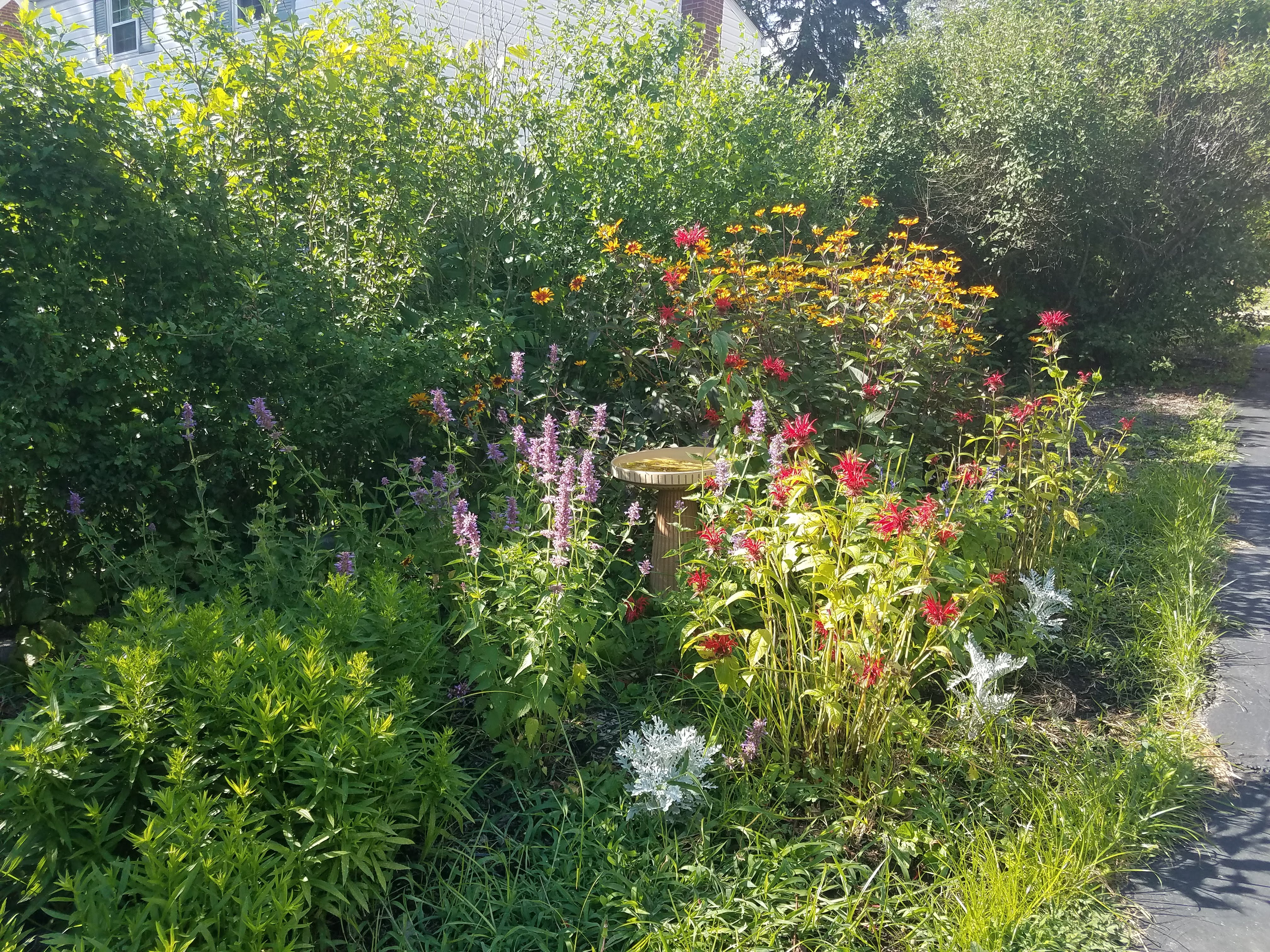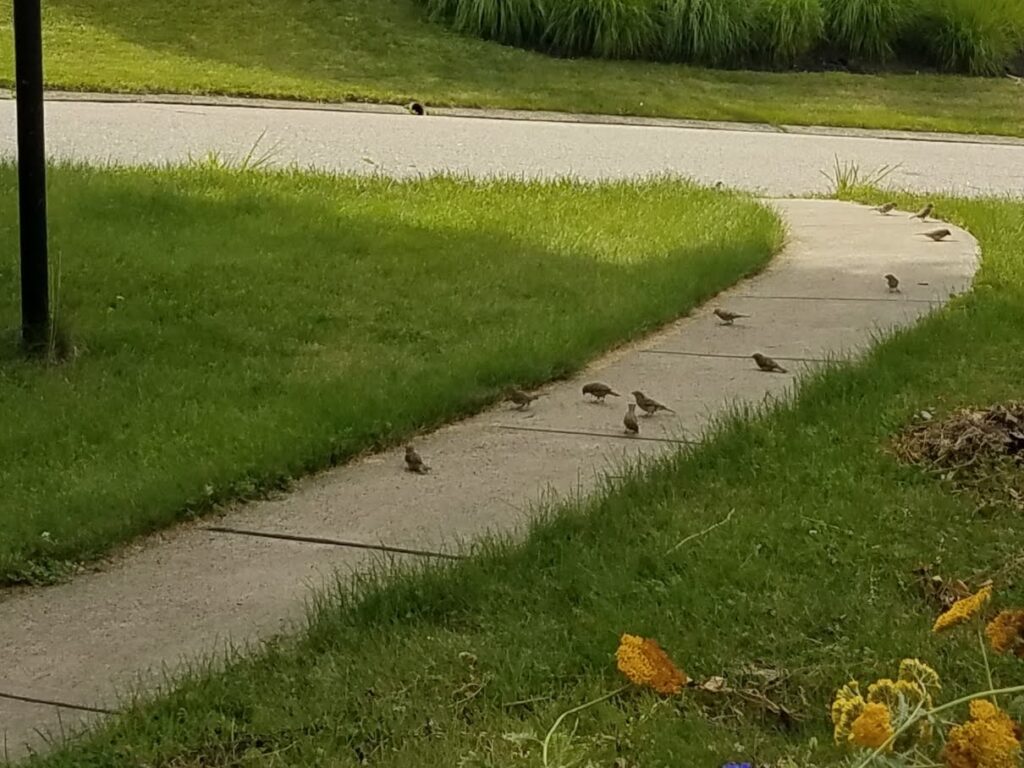In recent weeks, there have been reports throughout western Pennsylvania about a mysterious, new disease killing birds. I wrote this post while sitting on my porch, watching the various birds passing through my yard, willing them to stay safe. Although there is not much known at the moment, avian epidemiologists are working hard to find out more, and there are things that the rest of us can do to help protect them for now.
What We Know
Several types of songbirds, as well as robins, blue jays, and grackles have turned up with crusty eyes and neurological problems, sometimes dying in large numbers. Cases have been reported throughout parts of Appalachia and the mid-Atlantic through a tracking program run out of the University of Pennsylvania.[1] As the situation develops, scientists are looking into a variety of potential causes including toxins, bacterial and viral diseases, and parasites.[2]
Prevailing guidance at the moment is to take down bird feeders (including hummingbird feeders) and bird baths, to clean them with a 10% bleach solution, and to keep them down until further notice. It broke my heart to see our finches, sparrows, and chickadees hovering around where the feeder used to be, looking for food. However, I know it would break my heart even more to have to dispose of their dead bodies, especially knowing my bird feeder may have contributed to the spread of the disease. Should you find a dead bird, you are supposed to put it in a sealed plastic bag and throw it out with your household trash. Wash your hands well after touching it.

I have a lot of birdseed sitting on the porch, now getting ransacked by squirrels and groundhogs. (It can’t come inside – we tried that, and it introduced an extended family of moths into our kitchen.) My first inclination was to keep making use of the birdseed by spreading it on our front walk – the food would still be available for them, but they wouldn’t come into such close contact with each other. While I haven’t seen any guidance on that option either way, wildlife experts have been reassuring the public that birds will have enough to eat without the feeders. Given that, my thought would be that it’s still not a good idea to encourage them to congregate around scattered food because the birds themselves still seemed to cluster and interact closely on our walk.
I also took my hummingbird feeder down, which made me sad, but I have seen our hummingbirds move on to the salvia and monarda, meaning they’re finding alternate sources of nectar in the garden. The last unsolved issue in our yard is the fact that our grackles, robins, and jays eat the dry food I leave out for our neighborhood feral cats. I can’t stop feeding the cats, but I’ve tried to be better about putting the food out at regular times so it’s not sitting unattended for too long. As a result, the kitties are often waiting for me.
Ultimately, there is little known at the moment about the cause of this disease or how it is spread, which is why early guidance has been largely based on caution and preventing further transmission. Public health approaches for disease outbreaks with humans operate the same way. Think of guidance related to the COVID-19 pandemic (or in any zombie apocalypse movie you watched during the pandemic): travel is restricted, restaurants are closed, and people are told to stay indoors. Although the method of transmission usually isn’t known right away with a new disease, the first step is to limit any opportunities for potentially infected people to spread the disease. While we can’t limit travel for birds, we can effectively shut down their restaurants by removing bird feeders from our yards. Whether the disease is passed from bird to bird or through contact with common surfaces, keeping them from congregating will help to slow the spread while scientists learn more about how to stop it.

The Importance of Science Education
For better or worse, I frequent our neighborhood’s electronic bulletin board, where people can post questions, recommendations, news, and helpful information. Unfortunately, it is not well moderated, and not everything is useful or even factual. When I first posted the guidance from the Audubon Society instructing residents to take down bird feeders, I noted resistance from several people who argued that they hadn’t seen any diseased birds yet (so they shouldn’t have to do it), complained that they should be given more information about why this is happening (even though it is a new disease), and stated that I shouldn’t trust the government (despite “Audubon Society” appearing clearly in the headline).
It should not surprise anyone to hear that some of the people who responded to my post denying that this bird disease is even an issue have, over the last year, also been the most vocal about COVID-19 restrictions and whether COVID-19 is even real. I hesitate to even comment on the fact that these conversations are still happening and that COVID deniers still exist because to do so (even as I discredit their arguments) gives them some limited air time and their positions some limited credence. I bring up the issue now in this context not to complain about my neighbors who choose to remain willfully ignorant, but to comment on their state of ignorance in the first place.
The point that has been particularly concerning for me over the past year and a half, as I participate in conversations about two mysterious new diseases, is the perception that “science” is some kind of monolith that is right or wrong, has the answers or doesn’t, can be trusted or not. Last summer I wrote a four-part series about COVID-19 and spent the first part focusing on the scientific method and tried to stress the point that it is a method.[3]

(But that won’t stop me from posting reliable information for people who might benefit from it.)
Science doesn’t have the answers; science is a process for finding the answers, and the answers we find are based on the questions we ask. In conversations about COVID-19 and now with this new bird disease, I have seen broad skepticism of scientists and science in general because we don’t have all the answers right away. While these conversations represent teachable moments, and I try to take advantage of them whenever I have the time and energy to do so, it is incredibly frustrating to think that the concept of science as a process may not have been adequately covered in elementary school.
The state of science education in our school system – and how lack of scientific literacy can be used as a political tool – is an entirely different can of worms, one I’m not going to get into now. Suffice it to say that even a basic understanding of the scientific method among the general population is a huge part of the foundation of a sound and effective public health approach. If people aren’t going to follow science-based guidelines or understand that those guidelines may change as new information is gathered and incorporated, that will continue to put humans and animals at risk of preventable diseases.
So for the time being, here’s what you can do about the birds:
- Take down bird feeders and baths, and clean them with 10% bleach solution.
- Dispose of dead, diseased birds you find by putting them in a sealed plastic bag, and putting that out with your household garbage.
- Track any sightings of diseased or dead birds here.
- Calmly and clearly explain what is known / not known, as well as the importance of taking these steps when talking to someone who doesn’t see the value of preventative action.
Have you had any sightings in your area? Have you had a successful conversation with a skeptic? Please feel free to share your stories in the comments below.
Thanks for reading.
[1] http://www.vet.upenn.edu/research/centers-laboratories/research-initiatives/wildlife-futures-program/our-research/diseased-songbird-reporting-form
[2] https://www.alleghenyfront.org/researchers-trying-to-find-out-whats-causing-mysterious-bird-illness-death/
[3] https://radicalmoderate.online/face-masks-and-social-distancing-part-1/
0 Comments